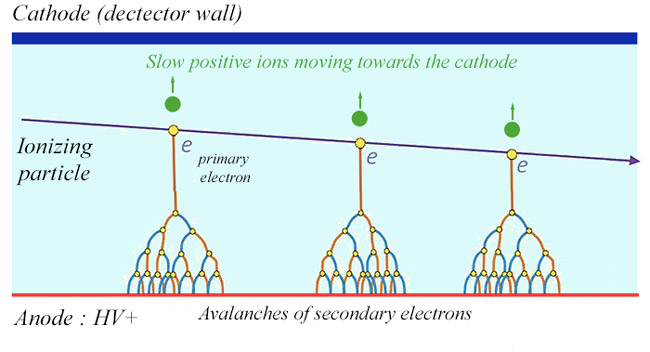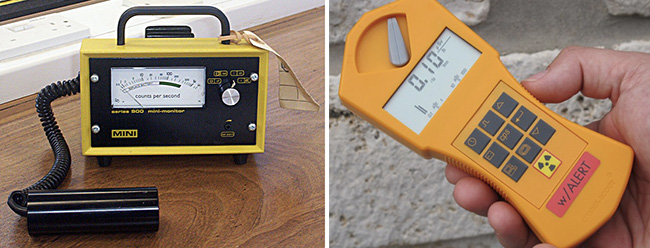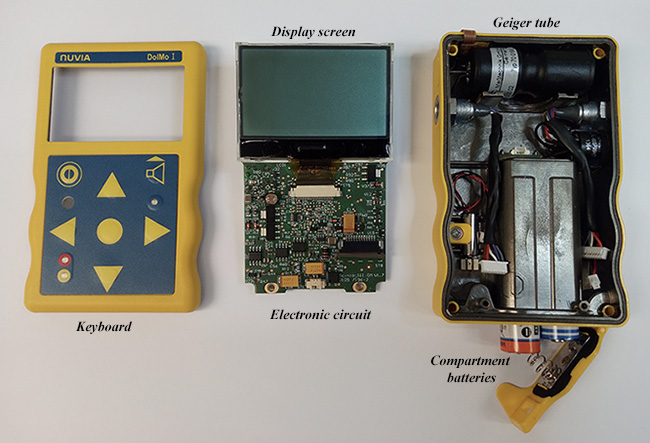A detector widely used in dosimetry, radioprotection, physics and industry
Widely used because of its portability and maneuverability, the Geiger – Mueller counter is perhaps one of the most widely used radiation detection instruments in the world, used in dosimetry, radiation protection, nuclear energy and nuclear energy. physics experiments. Very robust, it is relatively inexpensive. However, he does not distinguish the nature of radiation, does not measure their energy. Its performance is limited for measuring high radiation levels.
A Geiger counter usually consists of a tube (the sensitive element that detects radiation), with an electronic device for displaying the result. The tube is filled with an inert gas, helium, neon, argon. A strong electric field is applied, between the wall (cathode) and an anode wire located along its axis. In some counters, the tube is closed by a window (facing the measuring point) made of a light material permeable to ionizing radiation, generally a sheet of mica.
A particle passing through the gas ionizes the atoms it meets. Primary electrons ejected from atoms are accelerated by the strong electric field in the tube and travel to the anode wire. They excite and ionize other atoms in the gas they encounter, producing secondary electrons. These secondary electrons in turn ionize other atoms, ejecting other electrons, and so on. The emission of ultaviolet photons amplifies the phenomenon. Ultimately, it is an avalanche of electrons that reaches the anode wire and generates a highly amplified electrical pulse.

Avalanches of electrons amplify the signal
A charged particle ionizes atoms along its path of the gas that fills the tube volume. The positive ions created move slowly towards the cathode, because they are heavy. The primary electrons are attracted by the anode, brought to a positive voltage. Being light, they are accelerated and in turn tear other electrons from the gas atoms. Finally avalanches of electrons reaches the anode. The number of these avalanche electrons is very high (multiplying factor ranges from 1 million to 100 million). In a Geiger counter the tiny signal of the passage of a particle, thus amplified, can be detected.
© IN2P3
In the end, the amount of electric charges collected (global amplification factor of the order of a billion) is independent of the energy deposited by the initial particle. The avalanche does not make it possible to distinguish the nature of the primary radiation, nor to measure its energy.
The large electrical pulse resulting from the avalanches simplifies the electronics of Geiger counters, making their manufacture relatively inexpensive. The voltage between the anode wire and the tube wall is between 400-900 volts for large tubes. It is much lower in the case of the small tubes of portable counters, that use batteries. The pulses are shaped by the electronics to be counted. The result can be converted into sound (a « crackle » which allows the measurement to be eared) or displayed on a digital display, or both.

A variety of counters
In the Geiger counter on the left, the tube is separated from the box providing the power supply, the electronic circuits and the display of results. In the small counter on the right, used for measuring dose rates, all these elements are combined in a single box that can be held in one hand. The Geiger tube inside is small and requires smaller voltage.
© IN2P3
There is a wide variety of Geiger counters. There are two categories, depending on whether the tube has a window or not at its end.
– Tubes with window. Since the window is made of a light material such as mica, beta particles can enter the tube and be detected there. For the detection of alpha, which has a very short path, the source must be in quasi contact with the window.
– Tubes without window. These windowless tubes are used for gamma and x-ray detection and for measuring dose rates. The wall of the tube allows electrons to be produced by the compton effect or photoelectric effect, electrons which passi through the gas and produce avalanches which are detected.
Reading modes
There are two reading modes : a simple count of the detected radiation; a measurement of the radiation dose received.
– 1) Simple display of counting rates. The counting rate is the number of detected radiations recorded over a defined period of time, second, minute … This mode is normally used near a source emitting alpha or beta particles.
– 2) Evaluation of a dose rate resulting from gamma or X rays. This evaluation is delicate. The number of photons detected is not enough, because a Geiger – Müller tube does not measure their energy, which aenters also into the calculation of the received dose rates. To evaluate these dose rates from the count rates, it is necessary to apply an « energy compensation », which is performed by the electronics with corrective factors determined during the design and calibration of the apparatus. This “energy compensation” technique involves adding a screen of absorbent material around the tube. This filter preferentially absorbs low energy photons. The dose assessment is thus « improved ».

Components of a portable Geiger counter
Very handy portable detectors are used for the measurement of gamma and X rays dose rates. The electronic circuits and the display screen can be seen in the center ; on the right the tube and the battery compartment. The small dimensions of the tube allows to achieve the necessary electric field inside with batteries.
© Wikipedia
Limitations – There are two main limitations:
– Since the output pulse of a Geiger – Müller tube is of the same magnitude regardless of the energy of the incident radiation, the tube does not differentiate between types of radiation.
– An inability to measure high radiation levels due to the « dead time » of the tubes. A tube becomes temporarily insensitive after each ionization of the gas. During this « dead time » any other incident radiation will have no impact. (NB: To smother the discharge and reduce its duration, a little halogen gas or alcohol is added to the gas mixture). Ionization chambers are preferred for high radiation rates.